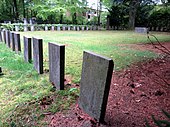Sigismund Samuel Hahn
Sigismund Samuel Hahn (born January 11, 1791 in Hamburg ; † April 11, 1870 there ) was a German Jewish officer in the Wars of Liberation and a Hamburg doctor.
Life
Sigismund Samuel Hahn attended the Johanneum School of Academics from 1804 to 1811 and then began studying human medicine and surgery at the newly opened University of Berlin . In 1813 he interrupted his studies and volunteered for the Hanseatic Legion . In 1815 he was captured by the French as a lieutenant in Belfort , but escaped wearing women's clothes. On October 5, 1816, he was able to successfully complete his studies in Berlin with a PhD. med. to lock.
He then undertook major trips, including to Italy, where he treated Lätitia Bonaparte in Rome . Then he practiced in Hamburg.
Hahn was a popular speaker, founding member and since 1866 honorary member of the Medical Association of Hamburg . Articles, occasional speeches and poems are published. He was reform-oriented and a member of the board of directors of the Jewish free school.
His grave obelisk, decorated with a representation of the war memorial of the Hanseatic Legion , is today in the Ohlsdorf Jewish cemetery in the immediate vicinity of the tomb of Georg Hartog Gerson . In addition, Sigismund Samuel Hahn is commemorated by a memorial stone in the neighboring site of honor.
Awards
Fonts
- Two speeches given on the foundation day of the Hanseatic Legion, March 16, 1828, and at the secular commemoration of the birth of Moses Mendelssohn on September 10, 1829. Hamburg: Hoffmann & Campe 1829
- About the origin and value of homeopathy. A sketch. Hamburg: Perthes 1834
- Words to Gabriel Riesser when he presented his medal. Berlin 1836
literature
- Hans Schröder (Hrg.) : Lexicon of the Hamburg writers up to the present. Volume 3, Hamburg 1857, p. 73 No. 1403 ( online )
Individual evidence
- ↑ a b Wolfgang Meyer: From the high school graduate register of the Johanneum 1804–1827. ( School program of the Johanneum 1906, p. 17 No. 29)
- ^ Eberhard Wolff: Medicine and Doctors in German Judaism of the Reform Era: The Architecture of a Modern Jewish Identity. (Jewish religion, history and culture (JRGK) 15) Göttingen: Vandenhoeck & Ruprecht 2014 ISBN 9783647569437 , pp. 135.154f
- ^ Ohlsdorf Jewish cemetery: The two obelisks
| personal data | |
|---|---|
| SURNAME | Hahn, Sigismund Samuel |
| BRIEF DESCRIPTION | German Jewish officer in the Wars of Liberation and Hamburg doctor |
| DATE OF BIRTH | January 11, 1791 |
| PLACE OF BIRTH | Hamburg |
| DATE OF DEATH | April 11, 1870 |
| Place of death | Hamburg |

